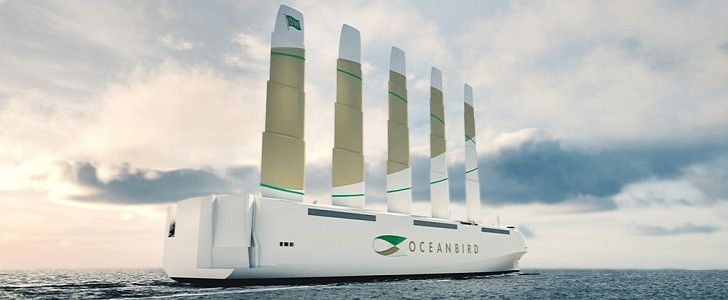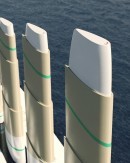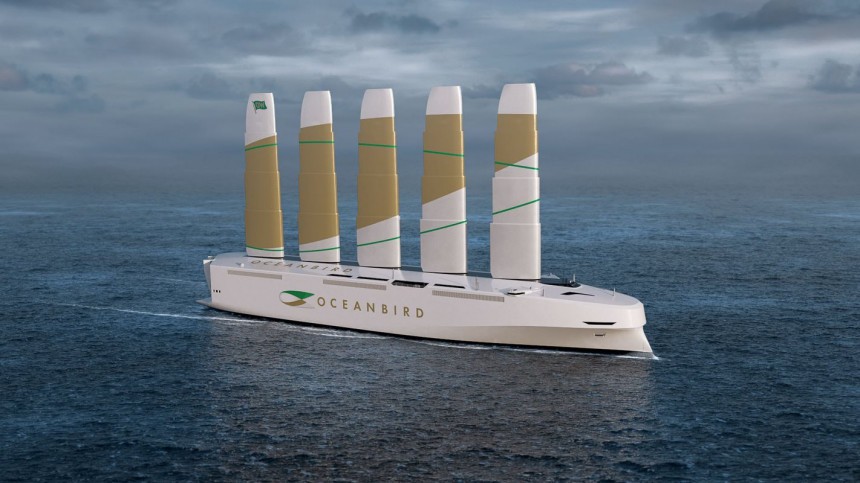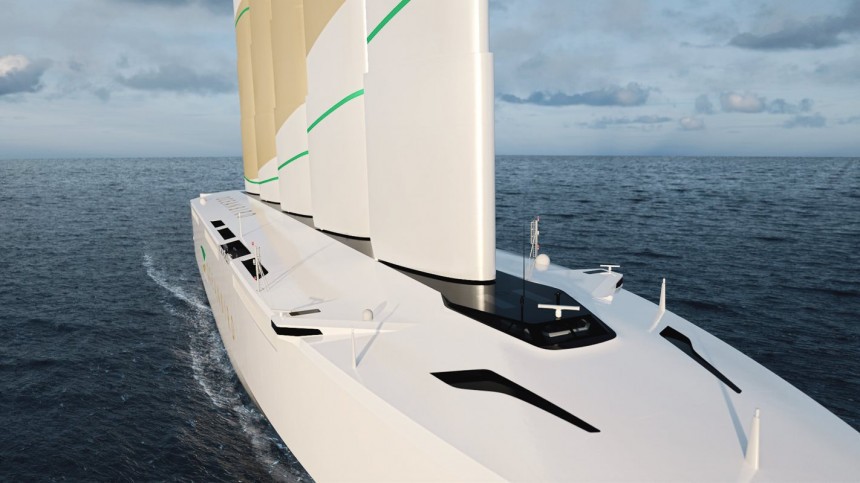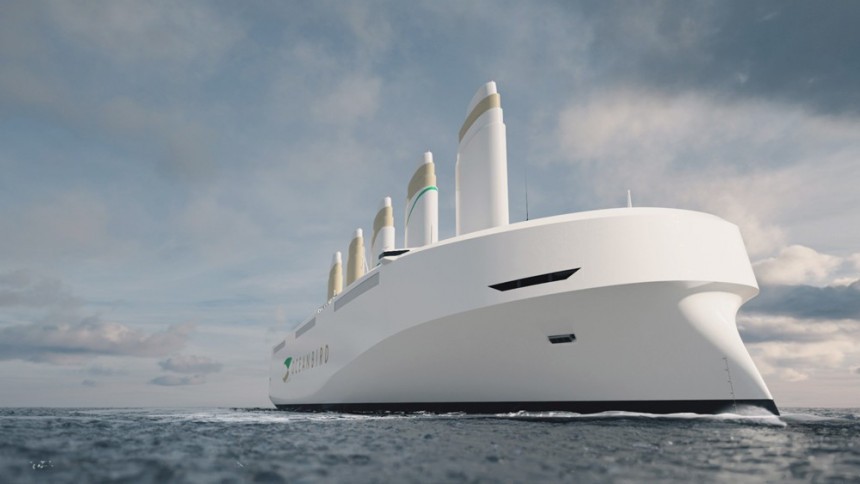The future may be electric for the automotive industry, but the naval industry is taking cues from aviation and the old-fashioned way of seafaring in order to hammer out the future. Meet Oceanbird, the wind-powered car carrier that aims to change the way we do transportation by sea.
Oceanbird is a mere concept for the time being, but not for long. Tests on a scale model in the real world are already being conducted and freight company Wallenius Marine, one of the parties behind the design, believes it could become a reality as soon as 2024.
We’ve spoken about wind-powered vessels on previous occasions, with Mathis Ruhl’s trimaran Wind Motion 70 being the most recent featured in a coverstory. Ruhl too believes that wind power is the cleanest way of achieving long-distance transportation by sea. However, in order to harness all the power of wind, special consideration must be given to sails and hull.
Oceanbird doesn’t have sails. It has wings instead.
Developed by Wallenius Marine in partnership with Stockholm’s KTH Royal Institute of Technology and maritime consultancy SSPA, with financial backing from the Swedish Transport Administration, Oceanbird is part of the Wind Powered Car Carrier (WPCC) Project. It is a new type of class called Pure Car and Truck Carrier (PCTC) that could haul some 7,000 vehicles across the Atlantic with 90 percent fewer emissions.
Oceabird takes cues from airplanes, utilizing four wings sitting at 80 meters (262.4 feet) above deck, or some 100 meters (328 feet) above the waterline. Made of steel and composite materials, they will generate forward thrust and pivot to 360 degrees for optimal use of wind power, moving the 32,000-ton vessel at a top speed of 10 knots. At 198 meters (650 feet) long, Oceanbird would be the biggest and the fastest sail vessel in the world (even though, technically, it doesn’t have sails).
According to the designers, the biggest challenge in creating this concept was creating rigging and a hull that would work together as a single unit. Unlike motorized vessels or even the traditional sail ship, the hull of Oceanbird has been optimized for improved aerodynamics and maximum efficiency. The designers estimate it could, at least in theory, cross the Atlantic in 12 days, taking 50 percent longer than today’s fuel-burning ships (7-8 days) but with the smallest footprint.
A backup motor would be included, presumably an electric one. It would kick in when traveling through harbors or other tricky areas. Also in harbors or when passing under bridges, the wings would collapse like a telescope, reaching heights no taller than 45 meters (150 feet). The telescopic adjustment would also be used to reef the sails under high winds.
Wallenius Marine says that this is their third iteration of the PCTC concept, and one they have the most faith in, being hailed as the “renaissance of wind-powered ships” and the cargo carrier that “will revolutionize” transportation by sea. The goal is to reduce greenhouse gasses by 90 percent, as compared to current methods.
“It is critical that shipping becomes sustainable,” the company says. “Our studies shows that wind is the most interesting energy source for ocean transports and with the 80 meter high wing sails on Oceanbird, we are developing the ocean-going freighters of the future.”
A 7-meter (22.9-foot) model is already being tested in open water. The order book will open in 2021, with a “possible launch” in 2024. While this project aims to develop the perfect wind-powered cargo ship, the partners agree that the same technology can be used for cruise ships and other types of large vessels.
Through the Oceanbird concept, the partners also aim to prove that the maritime industry can bring about change towards zero-emission shipping. Hopefully, it will happen before it's too late.
We’ve spoken about wind-powered vessels on previous occasions, with Mathis Ruhl’s trimaran Wind Motion 70 being the most recent featured in a coverstory. Ruhl too believes that wind power is the cleanest way of achieving long-distance transportation by sea. However, in order to harness all the power of wind, special consideration must be given to sails and hull.
Developed by Wallenius Marine in partnership with Stockholm’s KTH Royal Institute of Technology and maritime consultancy SSPA, with financial backing from the Swedish Transport Administration, Oceanbird is part of the Wind Powered Car Carrier (WPCC) Project. It is a new type of class called Pure Car and Truck Carrier (PCTC) that could haul some 7,000 vehicles across the Atlantic with 90 percent fewer emissions.
Oceabird takes cues from airplanes, utilizing four wings sitting at 80 meters (262.4 feet) above deck, or some 100 meters (328 feet) above the waterline. Made of steel and composite materials, they will generate forward thrust and pivot to 360 degrees for optimal use of wind power, moving the 32,000-ton vessel at a top speed of 10 knots. At 198 meters (650 feet) long, Oceanbird would be the biggest and the fastest sail vessel in the world (even though, technically, it doesn’t have sails).
A backup motor would be included, presumably an electric one. It would kick in when traveling through harbors or other tricky areas. Also in harbors or when passing under bridges, the wings would collapse like a telescope, reaching heights no taller than 45 meters (150 feet). The telescopic adjustment would also be used to reef the sails under high winds.
Wallenius Marine says that this is their third iteration of the PCTC concept, and one they have the most faith in, being hailed as the “renaissance of wind-powered ships” and the cargo carrier that “will revolutionize” transportation by sea. The goal is to reduce greenhouse gasses by 90 percent, as compared to current methods.
A 7-meter (22.9-foot) model is already being tested in open water. The order book will open in 2021, with a “possible launch” in 2024. While this project aims to develop the perfect wind-powered cargo ship, the partners agree that the same technology can be used for cruise ships and other types of large vessels.
Through the Oceanbird concept, the partners also aim to prove that the maritime industry can bring about change towards zero-emission shipping. Hopefully, it will happen before it's too late.
